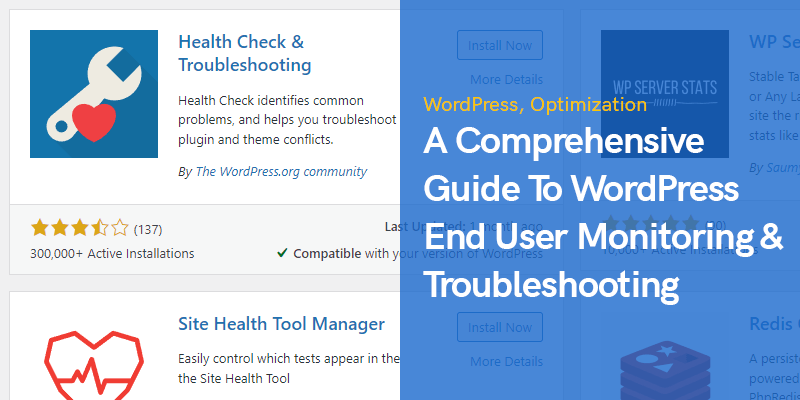
A Comprehensive Guide To WordPress End User Monitoring & Troubleshooting
Running a WordPress site comes with its fair share of trials and tribulations, so you need to be proactive in monitoring the end user experience, and troubleshooting issues that you find.
So how exactly can you go about achieving this efficiently and consistently?
WordPress End User Monitoring & Troubleshooting
Here are some tips and tools you’ll need to iron out problems with your WordPress-powered web presence.
Knowing Which Metrics to Track
The first thing to grasp is what you’ll need to look into to know whether there are complications to troubleshoot at all. If site speed is suffering, with pages loading slower than they should, this will clearly compromise the user experience (UX).
If downtime is spiking, and unplanned outages are common, visitors might not be able to access the site whatsoever.
If the number of requests received per second fluctuates wildly, it could be a sign that something is awry, even if the other metrics are comparatively stable.
It’s also necessary to use the Activity Log to check up on changes made to your site, so that you know what has been tinkered with, both from a monitoring and optimization perspective, as well as from a security point of view.
Using Monitoring Platforms to Your Advantage
There are tools out there that are designed to monitor the end-user experience and streamline the steps involved in troubleshooting dilemmas that crop up with WordPress sites from time to time.
These solutions can roll the aforementioned metrics and many more together into a cohesive, unified ecosystem, accessed through an intuitive interface, which lets you get an instant snapshot of the state of play from moment to moment, as well as giving you the ability to track it over time.
The upshot is that you’ll not only be able to see where and why the UX is falling short of expectations, but also to use this data to determine what’s getting in the way of potential conversions, and what you can do to address deficiencies in the design and infrastructure of your site.
Making Sure to Create a Backup
Another core tenet of troubleshooting in WordPress is making sure to implement a backup before you instigate any major changes.
There are plugins designed to do just that, and these should really be used even if you aren’t planning any significant behind-the-scenes reshuffling. It’s better to backup your site regularly, rather than leaving it to chance and then struggling to recover from an outage or outright loss.
Considering the Impact of Plugins
When it comes to actually troubleshooting flaws in your WordPress site that have been highlighted through unusual performance metrics or a monitoring tool, there are a few places to start.
The problem itself may point to a potential cause, but if this isn’t the case, then it’s time to be systematic in your next steps.
Often the culprit is a plugin that’s gone rogue and had some unintended side effects, so deactivating any third party integrations you’re using might be the quick fix you need to restore relative normality. From that point on, you can then reactivate plugins one at a time, keeping an eye on the metrics, to see if this is capable of identifying the wayward one.
Seeking expert assistance
If all else fails, it can be helpful to have specialist support on hand to return your WordPress site to full functionality.
This mainly applies to smaller businesses that are not capable of having permanent support staff in place. And if the UX of your WordPress presence is critical when it comes to winning new customers and keeping your brand afloat, outsourcing this is advised.
Recommended Posts

Marketing Tactics for WordPress Excellence in 2024
January 22, 2024

12 Reasons to Consider WordPress for Your First Website in 2024
January 17, 2024

Enhancing WordPress Sites with Computer Vision Capabilities
December 27, 2023